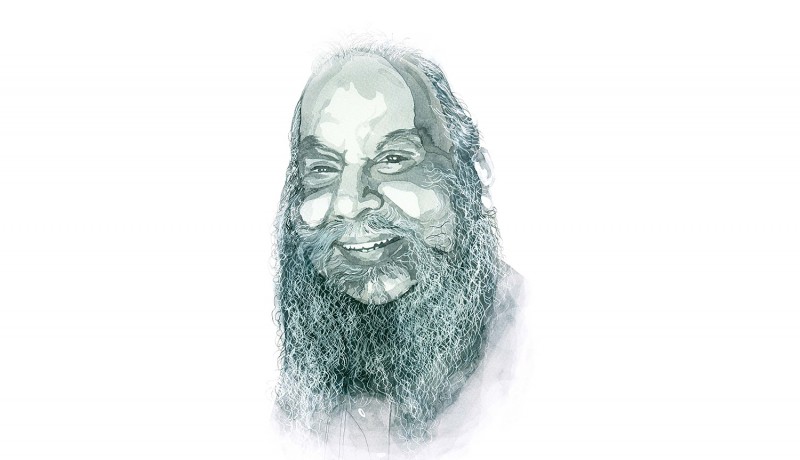
People

Painter
Born: 20 October 1947
Birthplace: Kolkata
India has led the way through its multifarious plurality—a wealth of thoughts, ideologies, faith, cultural diversities, social movements and history. The heritage of our country is defined by the harmonious coexistence of diverse groups. There exists a system that promotes the democracy of thought, secularism in practice and respect for individual freedom. The coexistence of tradition and modernity and a wealth of diversity are what I recognise as an integral part of the Indian ethos as a practising artist in India.
When I was a kid of about four or five, I enjoyed watching the people at my father’s dispensary. He was a physician. I observed and drew their features instinctively. As sports and games never appealed to me, drawing occupied me completely. As I grew, this turned into more than a hobby—it became my passion, the source of my confidence.
After school, I joined the Indian College of Art in Calcutta. My family was against it, so I fled my home and sought uncertain shelter wherever I could. My earnings then came from designing book covers and doing illustrations for newspapers. My first group exhibition was at the Academy of Fine Arts in 1969. Two of my works from that exhibition, Travail and The Ruler, were picked up by the National Gallery of Modern Art, New Delhi. Following this feat, I was spotted by the renowned Calcutta Painters, who invited me to join them. This catapulted me overnight from a promising neophyte to an artist who had come into his own.
In the early years, although the practice of art continued in its own small and scattered way, the number of galleries in India was few and far between. The only form of governmental support for the arts was through the Lalit Kala Akademi which has since gone on to support various groups and individual artists in the country. Because the art market was limited, I depended mostly on foreign patrons and sales for sustenance. A German couple who had bought two of my paintings from my studio invited me to bring my paintings to Geneva, Switzerland, in 1974. That was my first overseas exhibition. It laid the foundation for a number of exhibitions around Europe during that time.
The history of a structured market for art in our country is only a few decades old. While demand and appreciation for folk art were ever-present, it has taken a long time for modern and urban art to get the same acceptance. It was only in the ’60s, against the backdrop of a nascent independent nation, that modern art developed, and India slowly got a special place in the global modern art scene.
My visits to various art colleges abroad instilled in me a wish to establish an art college in India; this was realised in the founding of the College of Visual Arts in 1975. In 1984, I established Arts Acre – Village of Visual Arts. The late sitar maestro Pandit Ravi Shankar laid the foundation stone and Nobel laureate author Gunter Grass later inaugurated the institution. Artists stayed in cottages here, practised art and exhibited their works.
In the meantime, an art market developed in India marked by a proliferation of private art galleries across the country. There was no longer a need to lug artworks abroad in search of patrons. The period between 1995 and 2005 witnessed a meteoric rise in the Indian art market.
As the market grew, so did my dream to build a large art institution. I started work on expanding Arts Acre in 2008, and inaugurated it as an international centre for creativity and cultural vision spread over several acres of land in 2014. It also houses the Museum of Bengal Modern Art, which depicts the evolution of modern art from colonial times to the present day. This is a self-sufficient art institute, what I recognise to be the pinnacle of all that I have achieved in a life devoted to the practice, dissemination and development of art.
Going forward, unless the patronage and understanding of fine arts is encouraged among the common people, the appreciation of painting and sculpture will continue to remain within the confines of the elite.
Art is an expression of the deepest sensations of an artist’s mind, the reflection of his innermost self, a revelation that must be exposed to the common man. Just as beauty, peace, joy and harmony can vibrate a creative mind, so can anarchy, hatred, disharmony, and conflict move it to action.
These feelings of hurt, sorrow and desperation can inspire art. Amid disturbances, to create beauty. Amid anarchy, to create harmony. This representation is independent of one’s immediate environment, one’s society and one’s nation. For freedom is a quintessential gift for a creative mind.
Milestones
1969: Graduated from the Indian College of Art
1969: First group exhibition at Academy of Fine Arts, by the Society of Arts and Artists
1974: First exhibition overseas at Gallery Denburg in Geneva
1984: Established Arts Acre – Village of Visual Arts
2014: Expanded Arts Acre Foundation over several acres of land and set up the Museum of Bengal Modern Art
Current occupation: Devoted to painting and managing Arts Acre
Illustration by Sanjhi Shah Featured in Harmony — Celebrate Age Magazine August 2016
you may also like to read
-
For the love of Sanskrit
During her 60s, if you had told Sushila A that she would be securing a doctorate in Sanskrit in the….
-
Style sensation
Meet Instagram star Moon Lin Cocking a snook at ageism, this nonagenarian Taiwanese woman is slaying street fashion like….
-
Beauty and her beast
Meet Instagram star Linda Rodin Most beauty and style influencers on Instagram hope to launch their beauty line someday…..
-
Cooking up a storm!
Meet Instagram star Shanthi Ramachandran In today’s web-fuelled world, you can now get recipes for your favourite dishes at….







